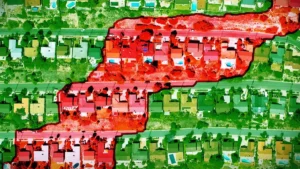 It is no secret that during the outset of the COVID-19 pandemic, many fled infectious, urban living settings to the suburbs and beyond, opting to give themselves some breathing room over remain in the expensive—and often cramped—city living.
It is no secret that during the outset of the COVID-19 pandemic, many fled infectious, urban living settings to the suburbs and beyond, opting to give themselves some breathing room over remain in the expensive—and often cramped—city living.
But as the story in the country goes, major metropolitan areas generally trend blue (or Democratic Party leading) while rural and suburban areas typically trend red (or Republican leaning).
According to new data from Redfin, red counties in battleground states gained roughly 340,000 residents from COVID-19 migration during 2021, the biggest gain since at least 2012. Purple counties (those with an equal representation of Democrats and Republicans) gained about 289,000 residents, again the largest increase in 10 years.
The data Redfin built their report on took polling and migration information from key battleground states of Arizona, Colorado, Florida, Georgia, Nevada, New Hampshire, North Carolina, Ohio, Pennsylvania and Wisconsin.
The trend is similar for purple counties in non-key states, with those gaining roughly 271,000 residents. Red counties in non-key states gained about 509,000 residents.
Continuing a decade-long trend, these red and purple counties have become increasingly diverse since the pandemic; these counties in the key states listed above are about one percentage point less white than they were in 2019.
Hispanic Americans also now make up a larger share of the population, albeit a slight increase of half a percentage point, while Black and Asian Americans also increased their population share in these key states.
2021 is the most recent year for which this data is available; Redfin noted that this diversification likely continued throughout 2022. This increased diversity has the potential to shift purple counties to blue counties this election cycle. In the 2020 election, 87% of Black Americans voted for Democratic candidates, as did 65% of Latinos, and 61% of Asians.
“These changes in racial makeup are small but noteworthy,” said Taylor Marr, Redfin’s Deputy Chief Economist. “The pandemic-driven wave of relocation to suburbs and rural areas—which tend to lean more conservative than city centers—made those toss-up places more diverse. The demographic shift isn’t big enough to turn solidly red places blue, but it could move the needle in purple areas.”
Marr continued: “Migration from California to Phoenix helped Democrats win Arizona in the 2020 presidential election for the first time in 24 years, and similar migration trends could tip the Senate midterms in Democrats’ favor in closely matched states like Georgia and Nevada.”
“Americans sorting themselves into neighborhoods to live near people similar to them has progressed over the past four decades,” Marr said. “When people relocate, they often choose an area made up of people similar to them. Some of the people, regardless of their race, who left liberal places and moved into red or purple counties were likely frustrated by local responses to the pandemic and relocated to places that better matched their lifestyles and political preferences.”
Click here to see Redfin’s research in its entirety.

 theMReport.com Your trusted source for mortgage banking news
theMReport.com Your trusted source for mortgage banking news








